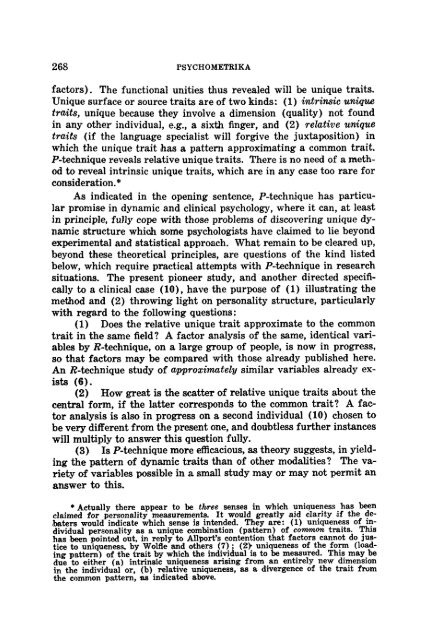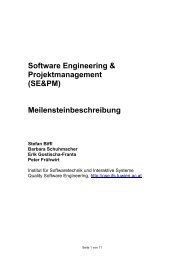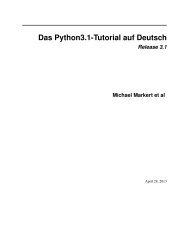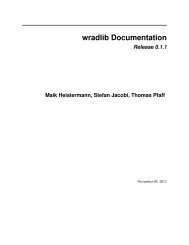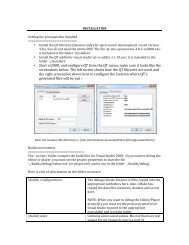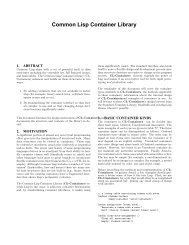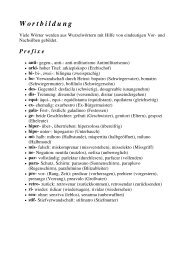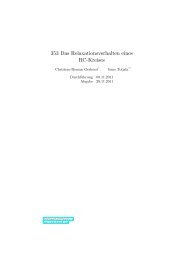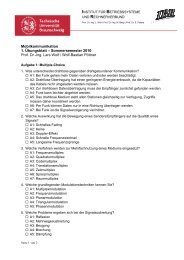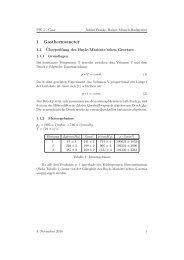P-Technique Demonstrated in Determining ... - Bitbucket
P-Technique Demonstrated in Determining ... - Bitbucket
P-Technique Demonstrated in Determining ... - Bitbucket
You also want an ePaper? Increase the reach of your titles
YUMPU automatically turns print PDFs into web optimized ePapers that Google loves.
268 PSYCHOMETRIKA<br />
factors). The functional unities thus revealed will be unique traits.<br />
Unique surface or source traits are of two k<strong>in</strong>ds: (1) <strong>in</strong>tr<strong>in</strong>sic uniq~<br />
trots, unique because they <strong>in</strong>volve a dimension (quality) not found<br />
<strong>in</strong> any other <strong>in</strong>dividual, e.g., a sixth f<strong>in</strong>ger, and (2) velative unique<br />
traits (if the language specialist will forgive the juxtaposition) <strong>in</strong><br />
which the unique trait has a pattern approximat<strong>in</strong>g a common trait.<br />
P-technique reveals relative unique traits. There is no need of a method<br />
to reveal <strong>in</strong>tr<strong>in</strong>sic unique traits, which are <strong>in</strong> any case too rare for<br />
consideration.*<br />
As <strong>in</strong>dicated <strong>in</strong> the open<strong>in</strong>g sentence, P-technique has particular<br />
promise <strong>in</strong> dynamic and cl<strong>in</strong>ical psychology, where it can, at least<br />
<strong>in</strong> pr<strong>in</strong>ciple, fuJly cope with those problems of discover<strong>in</strong>g unique dynamic<br />
structure which some psychologists have claimed to lie beyond<br />
experimental and statistical approach. What rema<strong>in</strong> to be cleared up,<br />
beyond these theoretical pr<strong>in</strong>ciples, are questions of the k<strong>in</strong>d listed<br />
below, which require practical attempts with P-technique <strong>in</strong> research<br />
situations. The present pioneer study, and another directed specifically<br />
to a cl<strong>in</strong>ical case (10), have the purpose of (1) illustrat<strong>in</strong>g the<br />
method and (2) throw<strong>in</strong>g light on personality structure, particularly<br />
with regard to the follow<strong>in</strong>g questions:<br />
(1) Does the relative unique trait approximate to the common<br />
trait <strong>in</strong> the same field ? A factor analysis of the same, identical variables<br />
by R-technique, on a large group of people, is now <strong>in</strong> progress,<br />
so that factors may be compared with those already published here.<br />
An R-technique study of approximately similar variables already exists<br />
(6).<br />
(2) How great is the scatter of relative unique traits about the<br />
central form, if the latter corresponds to the common trait ? A factor<br />
analysis is also <strong>in</strong> progress on a second <strong>in</strong>dividual (10) chosen to<br />
be very different from the present one, and doubtless further <strong>in</strong>stances<br />
will multiply to answer this question fully.<br />
(3) Is P-technique more efficacious, as theory suggests, <strong>in</strong> yield<strong>in</strong>g<br />
the pattern of dynamic traits than of other modal lties ? The variety<br />
of variables possible <strong>in</strong> a small study may or may not permit an<br />
answer to this.<br />
* Actually there appear to be three senses <strong>in</strong> which uniqueness has been<br />
claimed for personality measurements. It would greatly aid clarity ,~f the de-<br />
.baters would <strong>in</strong>dicate which sense is <strong>in</strong>tended. They are: (1) uniqueness of <strong>in</strong>dividual<br />
personality as a unique comb<strong>in</strong>ation (pattern) of con~mon traits. This<br />
has ,been po<strong>in</strong>ted out, <strong>in</strong> redly to Allport's contention that factors cannot do justice<br />
to uniqueness, by Wolfle and others (7) ; (2~ uniqueness of ~ne iorm (loaa<strong>in</strong>g<br />
pattern) of the trait by which the <strong>in</strong>dividual is to be measured. This may be<br />
due to either (a) <strong>in</strong>tr<strong>in</strong>sic uniqueness aris<strong>in</strong>g from an entirely new dimension<br />
<strong>in</strong> the <strong>in</strong>dividual or, (b) relative uniqueness, as a divergence of the trait from<br />
the common pattern, ~s <strong>in</strong>dicated above.


